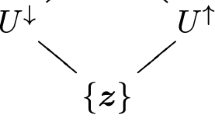Abstract
The standard model of the quantum theory of measurement is based on an interaction Hamiltonian in which the observable to be measured is multiplied by some observable of a probe system. This simple Ansatz has proved extremely fruitful in the development of the foundations of quantum mechanics. While the ensuing type of models has often been argued to be rather artificial, recent advances in quantum optics have demonstrated their principal and practical feasibility. A brief historical review of the standard model together with an outline of its virtues and limitations are presented as an illustration of the mutual inspiration that has always taken place between foundational and experimental research in quantum physics.
Similar content being viewed by others
References
M. Jammer,The Philosophy of Quantum Mechanics (Wiley, New York, 1974).
J. von Neumann,Mathematische Grundlagen der Quantenmechanik (Springer, Berlin, 1932): English transl.:Mathematical Foundations of Quantum Mechanics (Princeton University Press. Princeton. 1955).
Y. Aharonov and D. Bohm,Phys. Rev. 122, 1649 (1961).
P. Busch,Found. Phys. 20, 33 (1990).
C. M. Caves, K. S. Thorne, R. W. P. Drever, V. P. Sandberg, and M. Zimmerman,Rev. Mod. Phys. 52, 341 (1980). D. F. Walls, inSymposium on the Foundations of Modern Physics 1993. P. Busch, P. Lahti, and P. Mittelstaedt, eds. (World Scientific, Singapore, 1993).
E. Arthurs and J. L. Kelly,Bell Syst. Tech. J. 44, 725 (1965).
B. S. DeWitt, inFoundations of Quantum Mechanics, B. d'Espagnat. ed. (Academic, New York, 1972).
P. Busch, Doctoral Dissertation, Cologne 1982: English transl.:Int. J. Theor: Phys. 24, 63 (1985). P. Busch and P. J. Lahti,Philos. Sc. 52. 64 (1985).
P. Busch, M. Grabowski, and P. Lahli,Operational Quantum Physics (Springer, Berlin, 1995).
Y. Aharonov, D. Z. Albert, and L. Vaidman,Phys. Lett. A 124, 199 (1987):Phys. Rev. Lett. 60, 1351 (1988).
S. Stenholm,Ann. Phys. (N.Y.) 218, 233 (1992).
U. Leonhardt and H. Paul,Phys. Rev. A 47, R2460 (1993): U. Leonhardt,Phys. Rev: A 48, 3265 (1993).
J. W. Noh, A. Fougeres, and L. Mandel,Phys. Rev. A 45, 424 (1992):Phys. Rev. A 46, 2840 (1992).
P. Busch, P. Lahti, and P. Mittelstaedt,The Quantum Theory of Measurement (Springer, Berlin, 1991), 2nd edn. 1996.
Author information
Authors and Affiliations
Rights and permissions
About this article
Cite this article
Busch, P., Lahti, P.J. The standard model of quantum measurement theory: History and applications. Found Phys 26, 875–893 (1996). https://doi.org/10.1007/BF02148831
Received:
Issue Date:
DOI: https://doi.org/10.1007/BF02148831




